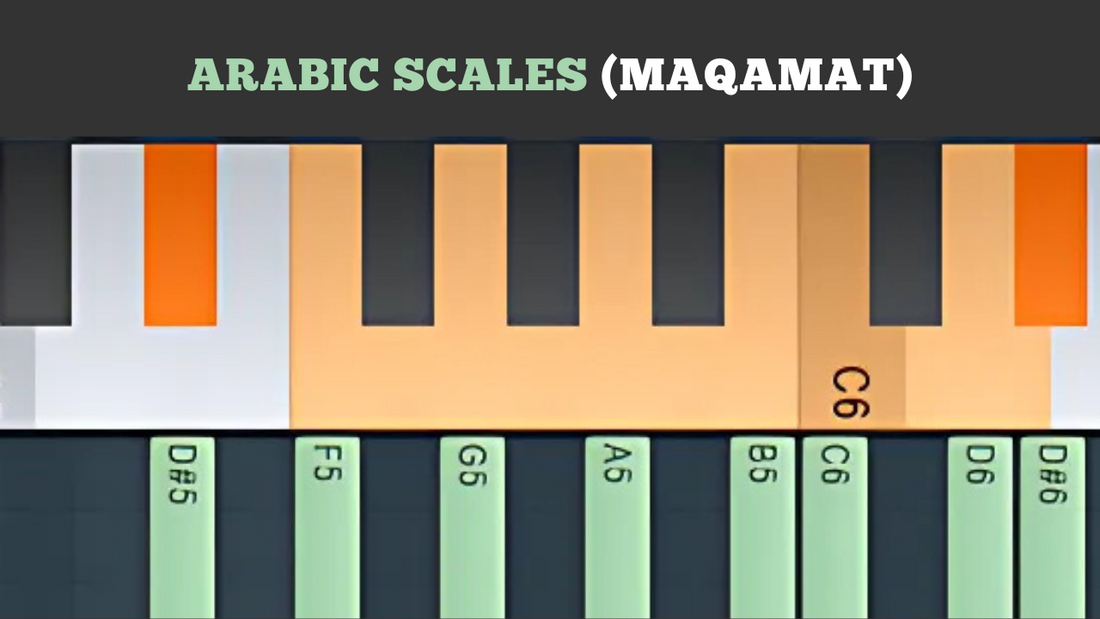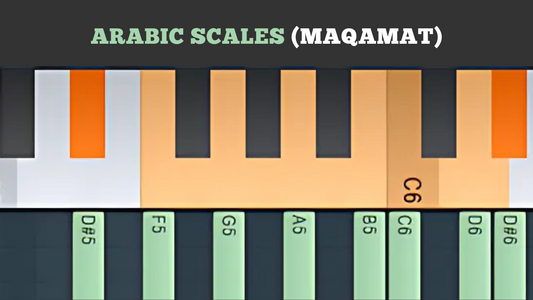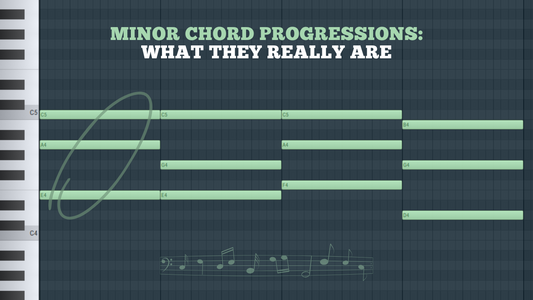
Arabic Scales (Maqamat): Everything You Need to Know
Share
Arabic scales, also known as maqamat, are musical modes built on unique intervals—often using quarter tones—that create the rich, emotional, and ornamented sound characteristic of Arabic music.
🎵 Common Arabic Maqamat + Quick Tips
Here’s a curated list of popular maqamat with bite-sized tips for each—great for producers, instrumentalists, and composers alike:
1. Maqam Rast (C – D – E♭↓ (quarter flat) – F – G – A – B♭↓ – C)

✅ Tip: Use it as the "major scale" of Arabic music; warm, noble vibe. Avoid over-accentuating the E♭↓—keep it subtle.
2. Maqam Bayati (D – E♭↓ – F – G – A – B♭ – C – D)

✅ Tip: Great for emotional, folk-style melodies. The E♭↓ gives it a soulful but grounded sound.
3. Maqam Hijaz (D – E♭ – F♯ – G – A – B♭ – C – D)

✅ Tip: Exotic and intense. The jump from E♭ to F♯ creates instant tension. Great for cinematic intros or dramatic hooks.
4. Maqam Nahawand (C – D – E♭ – F – G – A♭ – B♭ – C)

✅ Tip: Arabic minor scale. Feels familiar to Western ears, making it great for fusion. Add Arabic ornamentation for authenticity.
5. Maqam Saba (D – E♭↓ – F – G♭ – A – B♭ – C – D)

✅ Tip: Very emotional and melancholic. The G♭ is crucial—don’t skip it. Ideal for sad or spiritual vibes.
6. Maqam Kurd (D – E♭ – F – G – A♭ – B♭ – C – D)

✅ Tip: Dark and earthy. Think “Phrygian meets Middle East.” Great for deep grooves or darker storytelling.
7. Maqam Ajam (C – D – E – F – G – A – B – C)

✅ Tip: Closest to the Western major scale. Use it when you want brightness with an Arabic twist (via ornamentation or transitions).
8. Maqam Sikah (E↓ – F – G – A – B♭ – C – D – E↓)

✅ Tip: Centered on quarter-tone E↓. Rare and unique—used in religious or ceremonial settings. Hard to master but deeply expressive.
9. Maqam Hijazkar (C – D♭ – E – F – G – A♭ – B – C)

✅ Tip: Hijaz with more modulation potential. Great for creating melodic tension and surprise.
10. Maqam Huzam (a variant of Sikah)
✅ Tip: Use for improvisations and vocal solos. It lives in the space between notes—feel it, don’t just play it.
🔍 Deep Dive into the World of Maqamat
Introduction to Maqamat
In Arabic music, maqamat (singular: maqam) are more than just scales—they are expressive frameworks that define not only pitch and interval, but also emotion, ornamentation, and movement. Each maqam carries a unique mood, often linked to specific times of day, emotions, or cultural expressions.
Unlike Western music, which primarily uses whole and half steps, many Arabic maqamat incorporate microtonal intervals, particularly quarter tones—pitches that lie between the notes of the Western chromatic scale. These subtle variations give Arabic music its unmistakable flavor.
Structure of a Maqam
A typical maqam is built from jins (plural: ajnas), which are short sequences of 3 to 5 notes that function like melodic building blocks. A maqam usually consists of two or more ajnas, stacked to cover a full octave or more.
Each jins has its own character and rules of ornamentation, and the way ajnas are combined and modulated gives each maqam its distinct identity.
Example: Maqam Rast
-
First Jins (lower tetrachord): Rast on C – C, D, E-half-flat, F
-
Second Jins (upper tetrachord): Rast on G – G, A, B-half-flat, C
This maqam has a calm, noble, and uplifting quality. The E-half-flat and B-half-flat are microtonal notes, crucial to the identity of Rast and unavailable in Western scales.
Quarter Tones Explained
Quarter tones divide the whole tone into four equal parts (instead of two, as in Western music). This creates intervals of 50 cents (a cent is 1/100 of a semitone).
In Western music:
-
C → C♯ = 100 cents
In Arabic music: -
C → C-quarter-sharp = 50 cents
-
C → D = 200 cents
These in-between notes can’t be accurately played on standard Western instruments like the piano, which is why Arabic music often relies on instruments such as the oud, qanun, ney, or custom-fretted instruments that can produce these subtle pitches.
Emotional Depth and Tension
Each maqam expresses a specific emotional landscape:
-
Maqam Bayati – warm, expressive, often joyful
-
Maqam Hijaz – mystical, intense, often associated with longing
-
Maqam Saba – deeply melancholic and spiritual
-
Maqam Nahawand – close to the Western minor scale, emotional and nostalgic
Because of the microtonality and ornamentation involved, performers are expected to interpret a maqam, not just play it. This makes Arabic music inherently improvisational and deeply personal.
Modulation and Improvisation (Taqsim)
One of the most beautiful aspects of Arabic music is taqsim—a form of free, solo improvisation where the musician explores and modulates between maqamat. This showcases the performer’s emotional depth and technical mastery.
During a taqsim, the musician may:
-
Start in one maqam
-
Modulate to a related maqam
-
Return to the original or resolve to another maqam
These transitions are not arbitrary; they follow traditional paths and melodic logic, deeply rooted in centuries of musical practice.
Practical Application for Musicians
If you're a producer or musician working with Arabic sounds:
-
Study the most common maqamat (Rast, Bayati, Hijaz, Nahawand, Saba)
-
Learn to identify quarter tones by ear
-
Use sample-based instruments or VSTs that support Arabic tunings
-
Incorporate traditional instruments for authenticity
-
Work with Arabic vocalists or instrumentalists to bring real nuance
Conclusion
Arabic scales (maqamat) open the door to a deeply expressive and rich musical world that goes beyond mere theory. They are living, breathing systems that combine pitch, emotion, culture, and history into a sound that is instantly recognizable yet infinitely varied.
Whether you’re producing modern beats with Arabic flavor or diving deep into traditional improvisation, understanding maqamat will transform the way you think about melody and emotion in music.




